
- •1. Organic Compounds
- •1.1 Nomenclature of Organic Compounds
- •1.1.1 Nonfunctional Compounds
- •1.1.2 Functional Compounds
- •Table 1.9 Functional Class Names Used in Radicofunctional Nomenclature
- •Table 1.11 Names of Some Carboxylic Acids
- •1.1.4 Stereochemistry
- •1.1.5 Chemical Abstracts Indexing System
- •1.2 Physical Properties of Pure Substances

SECTION 1
ORGANIC COMPOUNDS
1.1 |
NOMENCLATURE OF ORGANIC COMPOUNDS |
1.1 |
1.1.1 |
Nonfunctional Compounds |
1.1 |
Table 1.1 Names of Straight-Chain Alkanes |
1.2 |
|
Table 1.2 Fused Polycyclic Hydrocarbons |
1.8 |
|
Table 1.3 Specialist Nomenclature for Heterocyclic Systems |
1.11 |
|
Table 1.4 Suffixes for Specialist Nomenclature of Heterocyclic Systems |
1.12 |
|
Table 1.5 Trivial Names of Heterocyclic Systems Suitable for Use in Fusion |
|
|
|
Names |
1.13 |
Table 1.6 Trivial Names for Heterocyclic Systems That Are Not Recommended |
|
|
|
for Use in Fusion Names |
1.16 |
1.1.2 |
Functional Compounds |
1.17 |
Table 1.7 Characteristic Groups for Substitutive Nomenclature |
1.18 |
|
Table 1.8 Characteristic Groups Cited Only as Prefixes in Substitutive |
|
|
|
Nomenclature |
1.19 |
Table 1.9 Functional Class Names Used in Radicofunctional Nomenclature |
1.22 |
|
1.1.3 |
Specific Functional Groups |
1.23 |
Table 1.10 Retained Trivial Names of Alcohols and Phenols with Structures |
1.24 |
|
Table 1.11 Names of Some Carboxylic Acids |
1.30 |
|
Table 1.12 Parent Structures of Phosphorus-Containing Compounds |
1.36 |
|
1.1.4 |
Stereochemistry |
1.39 |
1.1.5 |
Chemical Abstracts Indexing System |
1.49 |
Table 1.13 Names and Formulas of Organic Radicals |
1.51 |
|
1.2 PHYSICAL PROPERTIES OF PURE SUBSTANCES |
1.58 |
|
Table 1.14 Empirical Formula Index of Organic Compounds |
1.58 |
|
Table 1.15 Physical Constants of Organic Compounds |
1.74 |
|
1.1NOMENCLATURE OF ORGANIC COMPOUNDS
The following synopsis of rules for naming organic compounds and the examples given in expla- |
|
|
|||||
nation are not intended to cover all the possible cases. For a more comprehensive and detailed |
|
||||||
description, see J. Rigaudy and |
S. P. Klesney, |
Nomenclature |
of Organic |
Chemistry, |
Sections A, B, |
||
C, D, E, F, and H, Pergamon Press, Oxford, 1979. This publication contains the recommendations |
|
||||||
of the Commission on Nomenclature of Organic Chemistry and was prepared under the auspices of |
|
|
|||||
the International Union of Pure and Applied Chemistry (IUPAC). |
|
|
|
|
|||
1.1.1 |
Nonfunctional Compounds |
|
|
|
|
||
1.1.1.1 |
Alkanes. |
The saturated open-chain (acyclic) hydrocarbons |
have names ending(C nH 2n 2) |
|
|||
in -ane. The first four members have the trivial names |
|
methane |
(CH 4), ethane |
(CH 3CH 3 or C 2H6), |
|||
propane |
(C 3H8), and |
butane |
(C 4H10 ). For the remainder of the alkanes, the first portion of the name |
|
|||
1.1

1.2 SECTION 1
is derived from |
the Greek prefix (see Table 2.4) that cites the number of carbons in the alkane |
|
|
|
|
|||||||||||
followed by -ane with elision of the terminal -a from the prefix, as shown in Table 1.1. |
|
|
|
|
|
|
||||||||||
TABLE 1.1 |
Names of Straight-Chain Alkanes |
|
|
|
|
|
|
|
|
|
||||||
|
|
|
|
|
|
|
|
|
|
|
|
|
|
|
|
|
|
n * |
|
|
Name |
|
n * |
|
Name |
n * |
Name |
|
|
n * |
|
Name |
|
|
|
|
|
|
|
|
|
|
|
|
|
|
|
|
|
|
1 |
|
Methane |
11 |
|
Undecane‡ |
|
21 |
Henicosane |
60 |
Hexacontane |
|
|
|
|||
2 |
|
Ethane |
|
12 |
Dodecane |
|
22 |
Docosane |
70 |
Heptacontane |
|
|
||||
3 |
|
Propane |
13 |
|
Tridecane |
|
23 |
Tricosane |
80 |
Octacontane |
|
|
||||
4 |
|
Butane |
14 |
Tetradecane |
|
|
|
|
90 |
Nonacontane |
|
|
||||
5 |
|
Pentane |
15 |
Pentadecane |
|
30 |
Triacontane |
100 |
Hectane |
|
|
|||||
6 |
|
Hexane |
16 |
Hexadecane |
31 |
Hentriacontane |
110 |
Decahectane |
|
|
||||||
7 |
|
Heptane |
17 |
Heptadecane |
32 |
Dotriacontane |
120 |
Icosahectane |
|
|
||||||
8 |
|
Octane |
18 |
Octadecane |
|
|
|
|
121 |
Henicosahectane |
|
|
||||
9 |
|
Nonane† |
19 |
Nonadecane |
|
40 |
Tetracontane |
|
|
|
|
|
|
|||
10 |
|
Decane |
20 |
Icosane§ |
|
50 |
Pentacontane |
|
|
|
|
|
|
|||
|
|
|
|
|
|
|
|
|
|
|
|
|
|
|
||
|
*n |
total number of carbon atoms. |
|
|
|
|
|
|
|
|
|
|
||||
|
† Formerly called enneane. |
|
|
|
|
|
|
|
|
|
|
|||||
|
‡ Formerly called hendecane. |
|
|
|
|
|
|
|
|
|
|
|||||
|
§ Formerly called eicosane. |
|
|
|
|
|
|
|
|
|
|
|||||
For branching compounds, the parent structure is the longest continuous chain present in the |
|
|
|
|
|
|||||||||||
compound. Consider the compound to have been derived from this structure by replacement of |
|
|
|
|
|
|||||||||||
hydrogen by various alkyl groups. Arabic number prefixes indicate the carbon to which the alkyl |
|
|
|
|
|
|||||||||||
group is attached. Start numbering at whichever end of the parent structure that results in the lowest- |
|
|
|
|
|
|||||||||||
numbered locants. The arabic prefixes are listed in numerical |
|
sequence, separated from each |
other |
|
|
|
|
|
||||||||
by commas and from the remainder of the name by a hyphen. |
|
|
|
|
|
|
|
|
|
|||||||
If the same |
alkyl group occurs more than once as a side |
chain, this is indicated by the prefixes |
|
|
|
|
||||||||||
di-, tri-, tetra-, etc. Side chains are cited in alphabetical order (before insertion of any multiplying |
|
|
|
|
||||||||||||
prefix). The name of a complex radical (side chain) is considered to begin with the first letter of its |
|
|
|
|
|
|||||||||||
complete name. Where names of complex radicals are composed of identical words, priority for |
|
|
|
|
|
|||||||||||
citation is given to that radical which contains the lowest-numbered locant at the first cited point of |
|
|
|
|
|
|||||||||||
difference in the radical. If two or more side chains are in equivalent positions, the one to be assigned |
|
|
|
|
|
|||||||||||
the lowest-numbered locant is that cited first in the name. The complete expression for the side chain |
|
|
|
|
|
|||||||||||
may be enclosed in parentheses for clarity or the carbon atoms in side chains may be indicated by |
|
|
|
|
|
|||||||||||
primed locants. |
|
|
|
|
|
|
|
|
|
|
|
|
|
|
||
If hydrocarbon chains of equal length are competing for selection as the parent, the choice goes |
|
|
|
|
|
|||||||||||
in descending order to (1) the chain that has the greatest number of side chains, (2) the chain whose |
|
|
|
|
|
|||||||||||
side chains have the lowest-numbered locants, (3) the chain having the greatest number of carbon |
|
|
|
|
|
|||||||||||
atoms in the smaller side chains, or (4) the chain having the least-branched side chains. |
|
|
|
|
|
|
||||||||||
These trivial names may be used for the unsubstituted hydrocarbon only: |
|
|
|
|
|
|
|
|||||||||
Isobutane |
(CH |
3)2CHCH 3 |
|
|
|
Neopentane |
(CH |
3)4C |
|
|||||||
Isopentane |
(CH |
|
3)2CHCH 2CH 3 |
|
|
Isohexane |
(CH |
|
3)2CHCH 2CH 2CH 3 |
|||||||
Univalent radicals derived from saturated unbranched alkanes by removal of hydrogen from a terminal carbon atom are named by adding -yl in place of -ane to the stem name. Thus the alkane
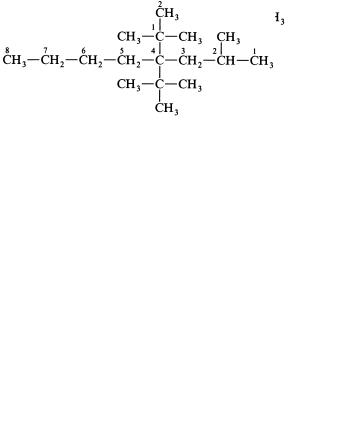
|
|
|
|
|
ORGANIC COMPOUNDS |
|
1.3 |
ethane |
becomes the |
radical |
ethyl. |
These exceptions are permitted |
for unsubstituted radicals |
||
only: |
|
|
|
|
|
|
|
Isopropyl |
(CH |
3)2CH 9 |
|
Isopentyl |
(CH |
3)2CHCH 2CH 2 9 |
|
Isobutyl |
(CH |
3)2CHCH 2 9 |
|
Neopentyl |
(CH |
3)3CCH 2 9 |
|
sec- |
Butyl |
CH |
3CH 2CH(CH 3) 9 |
tert- Pentyl |
CH |
3CH 2C(CH 3)2 9 |
|
tert |
-Butyl |
(CH |
3)3C 9 |
|
Isohexyl |
(CH |
3)2CHCH 2CH 2CH 2 9 |
Note the usage of the prefixes iso-, neo-, |
sec- , and |
tert- |
, and note when italics are employed. Italicized |
||
prefixes are never involved in alphabetization, except among themselves; thus |
|
sec- |
butyl would pre- |
||
cede isobutyl, isohexyl would precede isopropyl, and |
|
|
sec- butyl would precede |
tert- |
butyl. |
Examples of alkane nomenclature are |
|
|
|
|
|
2-Methylbutane (or the trivial name, isopentane)
3-Methylpentane (not 2-ethylbutane)
5-Ethyl-2,2-dimethyloctane (note cited order)
3-Ethyl-6-methyloctane (note locants reversed)
4,4-Bis(1,1-dimethylethyl)-2-methyloctane 4,4-Bis-1 ,1 -dimethylethyl-2-methyloctane 4,4-Bis( tert -butyl)-2-methyloctane
Bivalent radicals derived from saturated unbranched alkanes by removal of two hydrogen atoms are named as follows: (1) If both free bonds are on the same carbon atom, the ending -ane of the hydrocarbon is replaced with -ylidene. However, for the first member of the alkanes it is methylene
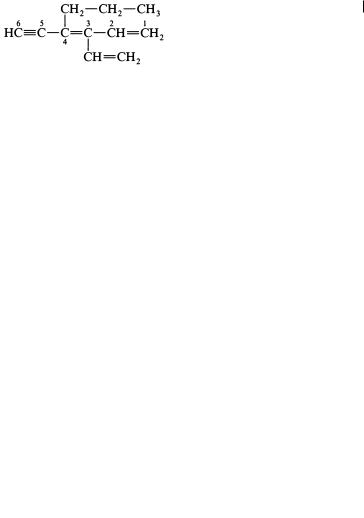
1.4 |
|
|
|
|
|
|
|
|
SECTION 1 |
|
|
|
|
rather |
than |
methylidene. Isopropylidene, |
|
|
|
sec |
-butylidene, |
and |
neopentylidene may be used for the |
||||
unsubstituted group only. (2) If the two free bonds are on different carbon atoms, the straight-chain |
|||||||||||||
group terminating in these two carbon atoms is named by citing the number of methylene groups |
|||||||||||||
comprising the chain. Other carbon groups are named as substituents. Ethylene is used rather than |
|||||||||||||
dimethylene for the first member of the series, |
and propylene is retained for |
|
|
|
|||||||||
(but trimethylene is |
9CH 2 9CH 2 9CH 2 9). |
|
|
|
|
||||||||
Trivalent groups derived by the removal of three |
hydrogen |
atoms from |
the |
same |
carbon are |
||||||||
named by replacing the ending -ane of the parent hydrocarbon with -ylidyne. |
|
|
|
|
|||||||||
1.1.1.2 |
|
Alkenes and |
Alkynes. |
|
Each name of the corresponding |
saturated hydrocarbon is con- |
|||||||
verted |
to |
the corresponding alkene by changing |
the |
ending -ane to -ene. For |
alkynes the |
ending is |
|||||||
-yne. With |
more than one double (or triple) bond, the endings are -adiene, -atriene, etc. (or -adiyne, |
||||||||||||
-atriyne, etc.). The position of the double (or triple) bond in the parent chain is indicated by a locant |
|||||||||||||
obtained |
by |
numbering |
from the end of the |
chain |
nearest |
the |
double |
(or |
triple) |
bond; thus |
|||
CH 3CH 2CH "CH 2 is 1-butene and CH |
|
3C #CCH 3 is 2-butyne. |
|||||||||||
For multiple unsaturated bonds, the chain is so |
numbered as to give the |
lowest possible locants |
|||||||||||
to the unsaturated bonds. When there is a choice in numbering, the double bonds are given the lowest |
|||||||||||||
locants, and the alkene is cited before the alkyne where both occur in the name. Examples: |
|||||||||||||
CH 3CH 2CH 2CH 2CH "CH 9CH "CH 2 |
1,3-Octadiene |
|
|||||||||||
CH 2 "CHC #CCH "CH 2 |
|
|
1,5-Hexadiene-3-yne |
|
|
|
|||||||
CH 3CH "CHCH 2C #CH |
|
4-Hexen-1-yne |
|
|
|
|
|
||||||
CH #CCH 2CH "CH 2 |
1-Penten-4-yne |
|
|
|
|
|
|
||||||
Unsaturated branched acyclic hydrocarbons are named as derivatives of the chain that contains the maximum number of double and/or triple bonds. When a choice exists, priority goes in sequence to (1) the chain with the greatest number of carbon atoms and (2) the chain containing the maximum number of double bonds.
These nonsystematic names are retained:
Ethylene CH 2 "CH 2
Allene CH 2 "C "CH 2
Acetylene HC #CH
An example of nomenclature for alkenes and alkynes is
4-Propyl-3-vinyl-1,3-hexadien-5-yne
Univalent radicals have the endings -enyl, -ynyl, -dienyl, -diynyl, etc. When necessary, the positions of the double and triple bonds are indicated by locants, with the carbon atom with the free valence numbered as 1. Examples:
CH 2 |
"CH 9CH 2 9 |
2-Propenyl |
CH 3 |
9C #C 9 |
1-Propynyl |
CH 3 |
9C #C 9CH 2CH "CH 2 9 1-Hexen-4-ynyl |
|
These names |
are retained: |
|
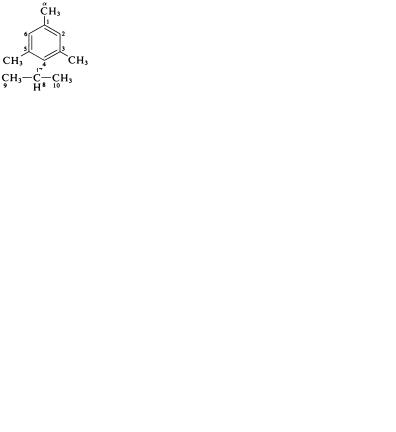
|
|
|
|
ORGANIC |
COMPOUNDS |
1.5 |
|
Vinyl (for ethenyl) |
CH |
2 "CH 9 |
|
|
|
||
Allyl (for 2-propenyl) |
CH |
2 "CH 9CH 2 9 |
|
||||
Isopropenyl (for 1-methylvinyl but for unsubstituted radical only) |
CH |
2 "C(CH 3) 9 |
|||||
Should there be a choice for the fundamental straight chain of |
a radical, that chain is selected |
||||||
which |
contains (1) the maximum number of double and triple bonds, (2) |
the largest number of |
|
||||
carbon atoms, and (3) the largest number of double bonds. These are in descending priority. |
|
||||||
Bivalent radicals derived from unbranched alkenes, alkadienes, and alkynes by removing a hy- |
|
||||||
drogen |
|
atom from each of the |
terminal carbon atoms are named by |
replacing the endings -ene, |
|
||
-diene, and -yne by -enylene, -dienylene, and -ynylene, respectively. Positions of double and triple |
|
||||||
bonds are indicated by numbers when necessary. The name |
|
vinylene |
instead of ethenylene is retained |
||||
for |
9CH "CH 9. |
|
|
|
|
|
|
1.1.1.3 |
Monocyclic Aliphatic |
Hydrocarbons. |
|
|
Monocyclic aliphatic hydrocarbons (with no side |
||
chains) are named by prefixing cycloto the name of the corresponding open-chain hydrocarbon |
|
||||||
having the same number of carbon atoms as |
the ring. Radicals are |
formed |
as with the alkanes, |
|
|||
alkenes, and alkynes. Examples: |
|
|
|
|
|||
|
|
Cyclohexane |
Cyclohexyl- (for the radical) |
|
|||
|
|
Cyclohexene |
1-Cyclohexenyl- (for the radical with the free valence at |
||||
|
|
|
|
carbon 1) |
|
|
|
|
|
1,3-Cyclohexandiene |
Cyclohexadienyl- (the unsaturated carbons are given |
||||
|
|
|
|
numbers as low as possible, numbering from the carbon |
|||
|
|
|
|
atom |
with the free valence given the |
number 1) |
|
For convenience, aliphatic rings are often represented by simple geometric figures: a triangle for cyclopropane, a square for cyclobutane, a pentagon for cyclopentane, a hexagon (as illustrated) for cyclohexane, etc. It is understood that two hydrogen atoms are located at each corner of the figure unless some other group is indicated for one or both.
1.1.1.4 |
Monocyclic Aromatic |
Compounds. |
Except for six retained names, all monocyclic sub- |
stituted aromatic hydrocarbons are named systematically as derivatives of benzene. Moreover, if the |
|||
substituent introduced into a compound with a retained trivial name is identical with one already |
|||
present |
in that compound, the |
compound is |
named as a derivative of benzene. These names are |
retained:
Cumene |
Cymene (all three |
Mesitylene |
|
|
forms; |
para |
- shown) |

1.6 |
SECTION 1 |
|
|
|
|
Styrene |
Toluene |
Xylene (all three |
|
|
|
|
|
|
|
|
|
|
|
forms; |
meta |
- shown) |
|
|
|
The position of substituents is indicated by numbers, with the lowest locant possible given to |
|
|
|
||||||||
substituents. |
When |
a name is based on a recognized trivial name, priority for lowest-numbered |
|
|
|
||||||
locants is given to substituents implied by the trivial name. When only two substituents are present |
|
|
|
|
|||||||
on a benzene ring, their position may be indicated by |
o - ( ortho |
-), m |
- ( meta |
-), and |
p - ( para -) (and |
||||||
alphabetized in the order given) used in place of 1,2-, 1,3-, and 1,4-, respectively. |
|
|
|
|
|
||||||
Radicals derived from monocyclic substituted aromatic hydrocarbons and having the free valence |
|
|
|
|
|||||||
at a ring atom (numbered 1) are named phenyl (for benzene as parent, since benzyl is used for the |
|
|
|
||||||||
radical C |
|
6H5CH 2 9), cumenyl, mesityl, tolyl, and xylyl. All other radicals are named as substituted |
|
|
|||||||
phenyl radicals. For radicals having a single free valence in the side chain, these trivial names are |
|
|
|
||||||||
retained: |
|
|
|
|
|
|
|
|
|
|
|
Benzyl |
|
C |
6H5CH 2 9 |
|
|
Phenethyl |
C |
6H5CH 2CH 2 9 |
|
||
Benzhydryl (alternative to |
|
|
Styryl |
C |
6H5CH "CH 9 |
|
|||||
diphenylmethyl) |
(C |
6H5)2CH 9 |
Trityl |
(C |
6H5)3C 9 |
|
|
||||
|
|
|
|
|
|
|
|
||||
Cinnamyl |
|
C |
6H5CH "CH 9CH 2 9 |
|
|
|
|
|
|
||
Otherwise, radicals having the free valence(s) in the side chain are named in accordance with the |
|
|
|
|
|||||||
rules for alkanes, alkenes, or alkynes. |
|
|
|
|
|
|
|
||||
The name |
|
phenylene |
(o -, m -, or |
p -) is retained for the radical |
9C 6H4 9. Bivalent radicals formed |
||||||
from substituted benzene derivatives and having the free valences at ring atoms are named as sub- |
|
|
|
|
|||||||
stituted phenylene radicals, with the carbon atoms having the free |
valences being numbered 1,2-, |
|
|
|
|
||||||
1,3-, or 1,4-, as appropriate. |
|
|
|
|
|
|
|
|
|||
Radicals having three or more free valences are named by adding the suffixes -triyl, -tetrayl, etc. |
|
|
|
||||||||
to the systematic name of the corresponding hydrocarbon. |
|
|
|
|
|
|
|||||
1.1.1.5 |
Fused Polycyclic Hydrocarbons. |
|
The names of polycyclic |
hydrocarbons |
containing |
the |
|
||||
maximum number of conjugated double bonds end in -ene. Here the ending does not denote one double bond. Names of hydrocarbons containing five or more fixed benzene rings in a linear arrangement are formed from a numerical prefix (see Table 2.4) followed by -acene. A partial list of the names of polycyclic hydrocarbons is given in Table 1.2. Many names are trivial.
Numbering of each ring system is fixed, as shown in Table 1.2, but it follows a systematic pattern. The individual rings of each system are oriented so that the greatest number of rings are (1) in a horizontal row and (2) the maximum number of rings are above and to the right (upper-right quadrant) of the horizontal row. When two orientations meet these requirements, the one is chosen that has the fewest rings in the lower-left quadrant. Numbering proceeds in a clockwise direction, commencing with the carbon atom not engaged in ring fusion that lies in the most counterclockwise position of the uppermost ring (upper-right quadrant); omit atoms common to two or more rings. Atoms common to two or more rings are designated by adding lowercase roman letters to the number
of the position immediately preceding. Interior atoms follow the highest number, taking a clockwise
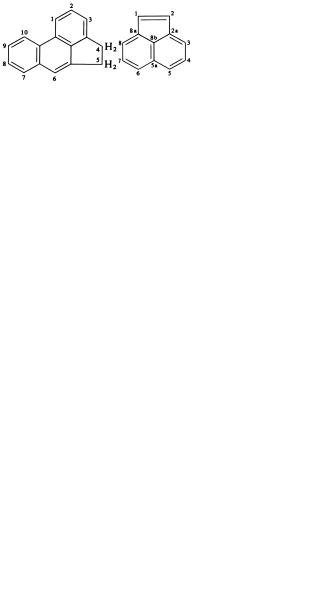
|
ORGANIC COMPOUNDS |
1.7 |
sequence wherever there is a |
choice. Anthracene and phenanthrene are two exceptions to |
the rule |
on numbering. Two examples of |
numbering follow: |
|
|
When a ring system with the maximum number of conjugated double bonds can exist in two or |
|||||||||
more forms |
differing |
only in the position of an “extra” hydrogen atom, the name can be made |
||||||||
specific |
by |
indicating |
the position of |
the |
extra hydrogen(s). The compound |
name |
is modified with |
|||
a |
locant |
followed by |
an |
italic capital |
|
H for each of |
these |
hydrogen atoms. Carbon atoms that carry |
||
an |
indicated |
hydrogen |
atom |
are numbered |
as low as possible. For example, 1 |
|
H -indene is illustrated |
|||
in Table 1.2; 2 |
|
H |
-indene would be |
|
|
|
||||
Names of polycyclic hydrocarbons with less than the maximum number of noncumulative double bonds are formed from a prefix dihydro-, tetrahydro-, etc., followed by the name of the corresponding unreduced hydrocarbon. The prefix perhydrosignifies full hydrogenation. For example, 1,2-dihy- dronaphthalene is
Examples of retained names and their structures are as follows:
Indan |
Acenaphthene |
Aceanthrene |
Acephenanthrene
Polycyclic compounds in which two rings have two atoms in common or in which one ring contains two atoms in common with each of two or more rings of a contiguous series of rings and which contain at least two rings of five or more members with the maximum number of noncumu-
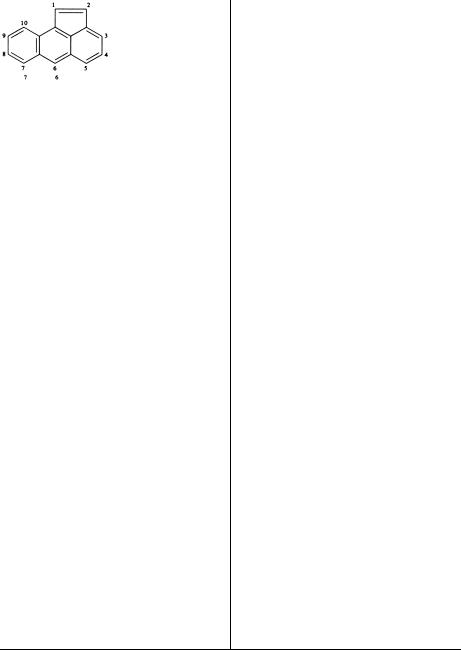
1.8 |
SECTION 1 |
|
TABLE 1.2 |
Fused Polycyclic Hydrocarbons |
|
Listed in order of increasing priority for selection as parent compound. |
||
|
|
|
|
1. Pentalene |
9. Acenaphthylene |
2. Indene
10. Fluorene
3. Naphthalene |
11. Phenalene |
|
4. Azulene
12. Phenanthrene*
5. Heptalene
13. Anthracene*
14. Fluoranthene
6. Biphenylene
7. asym- |
Indacene |
15. Acephenanthrylene |
|
|
8. sym- Indacene |
16. Aceanthrylene |
* Asterisk after a compound denotes exception to systematic numbering.
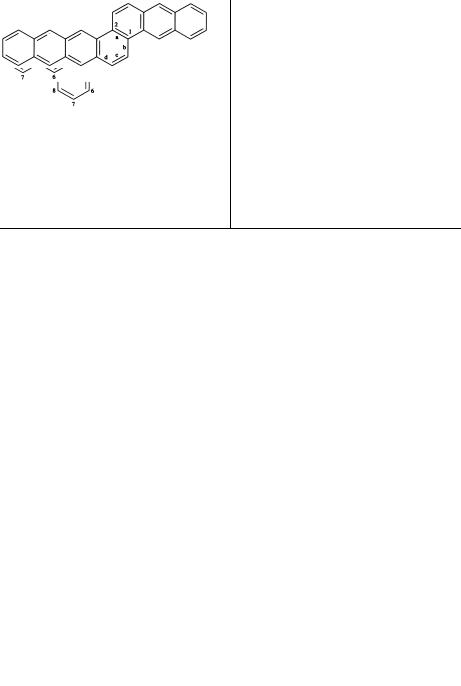
ORGANIC |
COMPOUNDS |
1.9 |
|
TABLE 1.2 Fused Polycyclic Hydrocarbons ( |
Continued |
) |
|
|
|
|
|
17. Triphenylene |
|
19. Chrysene |
|
18. Pyrene |
20. Naphthacene |
lative double bonds and which have no accepted trivial name (Table 1.2) are named by prefixing to the name of the parent ring or ring system designations of the other components. The parent name should contain as many rings as possible (provided it has a trivial name) and should occur as far as possible from the beginning of the list in Table 1.2. Furthermore, the attached component(s) should be as simple as possible. For example, one writes dibenzophenanthrene and not naphthophenanthrene because the attached component benzois simpler than napththo-. Prefixes designating attached components are formed by changing the ending -ene into -eno-; for example, indenofrom indene.
Multiple prefixes are arranged in alphabetical order. Several abbreviated prefixes are recognized; the parent is given in parentheses:
Acenaphtho- |
(acenaphthylene) |
Naphtho- |
(naphthalene) |
|
||
Anthra- |
(anthracene) |
Perylo- |
(perylene) |
|
||
Benzo- |
(benzene) |
|
Phenanthro- |
(phenanthrene) |
||
For monocyclic prefixes other than benzo-, the following |
names are recognized, each to represent |
|||||
the form with the maximum number of noncumulative double bonds: cyclopenta-, cyclohepta-, |
|
|||||
cycloocta-, |
etc. |
|
|
|
|
|
Isomers are distinguished by lettering the peripheral |
sides of the parent beginning with |
a for the |
||||
side 1,2, |
and so on, lettering every side around the periphery. If |
necessary |
for |
clarity, the |
numbers |
|
of the attached position (1,2, for example) of the substituent ring are also denoted. The prefixes are cited in alphabetical order. The numbers and letters are enclosed in square brackets and placed immediately after the designation of the attached component. Examples are
Benz[ ]anthracene |
Anthra[2,1- |
]naphthacene |
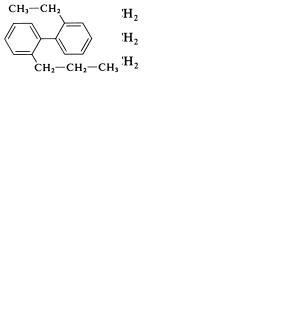
1.10 |
|
SECTION 1 |
1.1.1.6 |
Bridged Hydrocarbons. |
Saturated alicyclic hydrocarbon systems consisting of two rings |
that have two or more atoms in common take |
the name of the open-chain hydrocarbon containing |
|
the same |
total number of carbon atoms and |
are preceded by the prefix bicyclo-. The system is |
numbered commencing with one of the bridgeheads, numbering proceeding by the longest possible path to the second bridgehead. Numbering is then continued from this atom by the longer remaining
unnumbered path back to the first bridgehead and is completed by the shortest path from the atom next to the first bridgehead. When a choice in numbering exists, unsaturation is given the lowest numbers. The number of carbon atoms in each of the bridges connecting the bridgeheads is indicated
in brackets in descending order. Examples are
|
Bicyclo[3.2.1]octane |
Bicyclo[5.2.0]nonane |
|
1.1.1.7 |
Hydrocarbon Ring Assemblies. |
Assemblies are two or more cyclic systems, either single |
|
rings or fused systems, that are joined directly to each other by double or single bonds. For identical |
|||
systems naming may proceed (1) by placing the prefix bibefore the name of the corresponding |
|||
radical or |
(2), for systems joined through a single bond, by |
placing the prefix bibefore the name |
|
of the corresponding hydrocarbon. In each case, the numbering of the assembly is that of the cor- |
|||
responding |
radical or hydrocarbon, one system being assigned |
unprimed numbers and the other |
|
primed numbers. The points of attachment are indicated by placing the appropriate |
locants before |
||
the name; an unprimed number is considered lower than the same number primed. The name |
biphenyl |
||
is used for |
the assembly consisting of two benzene rings. Examples are |
|
|
1,1 -Bicyclopropyl or 1,1 |
-bicyclopropane |
2-Ethyl-2 |
-propylbiphenyl |
|
For nonidentical ring systems, |
one ring system |
is selected as the parent and the other systems |
|
|
are considered as substituents and |
are arranged in alphabetical order. The parent ring system is |
|
||
assigned unprimed numbers. The parent is chosen by |
considering the following |
characteristics in |
|
|
turn until a decision is reached: (1) the system containing the larger number of rings, (2) the system containing the larger ring, (3) the system in the lowest state of hydrogenation, and (4) the highestorder number of ring systems set forth in Table 1.2. Examples are given, with the deciding priority given in parentheses preceding the name:
(1) 2-Phenylnaphthalene
(2)and (4) 2-(2 -Naphthyl)azulene
(3)Cyclohexylbenzene
1.1.1.8Radicals from Ring Systems. Univalent substituent groups derived from polycyclic hy-
drocarbons are named by changing the final |
e of the hydrocarbon name to -yl. The carbon atoms |
having free valences are given locants as low as possible consistent with the fixed numbering of the

ORGANIC COMPOUNDS |
1.11 |
hydrocarbon. Exceptions are naphthyl (instead of naphthalenyl), anthryl (for anthracenyl), and phenanthryl (for phenanthrenyl). However, these abbreviated forms are used only for the simple ring systems. Substituting groups derived from fused derivatives of these ring systems are named systematically. Substituting groups having two or more free bonds are named as described in Monocyclic Aliphatic Hydrocarbons on p. 1.5.
1.1.1.9 |
Cyclic Hydrocarbons with Side Chains. |
Hydrocarbons composed of cyclic and aliphatic |
||
chains are named in a manner that is the simplest permissible or the most appropriate for the chemical |
|
|||
intent. Hydrocarbons containing several chains attached to one cyclic nucleus are generally named |
|
|||
as derivatives of the cyclic compound, and compounds containing several side chains and/or cyclic |
|
|||
radicals attached to one chain are named as derivatives of the acyclic compound. Examples are |
|
|||
2-Ethyl-1-methylnaphthalene |
|
Diphenylmethane |
|
|
1,5-Diphenylpentane |
|
2,3-Dimethyl-1-phenyl-1-hexene |
||
Recognized trivial names for composite radicals are used if they lead to simplifications in naming. |
||||
Examples are |
|
|
|
|
1-Benzylnaphthalene |
|
1,2,4-Tris(3- |
p -tolylpropyl)benzene |
|
Fulvene, for methylenecyclopentadiene, and stilbene, for 1,2-diphenylethylene, are trivial names |
|
|||
that are |
retained. |
|
|
|
1.1.1.10 |
Heterocyclic Systems. |
Heterocyclic compounds can be named by relating them to the |
||
corresponding carbocyclic ring systems by using replacement nomenclature. Heteroatoms are de- |
|
|||
noted by prefixes ending in |
a , as shown in Table 1.3. If two or more replacement prefixes are required |
|||
in a single name, they are cited in the order of |
their listing in the table. The lowest possible num- |
|||
bers consistent with the numbering of the corresponding carbocyclic system are assigned to the |
|
|||
heteroatoms and then to carbon atoms bearing double or triple bonds. Locants are cited immediately |
|
|||
preceding the prefixes or suffixes to which they refer. Multiplicity of the same heteroatom is indicated |
|
|||
by the appropriate prefix in the |
series: di-, tri-, tetra-, penta-, hexa-, etc. |
|
||
TABLE 1.3 |
Specialist Nomenclature for Heterocyclic Systems |
|
|
|
|
|
||
Heterocyclic atoms are listed in decreasing order of priority. |
|
|
|
|
|
|||
|
|
|
|
|
|
|
|
|
Element |
|
Valence |
Prefix |
Element |
Valence |
|
Prefix |
|
|
|
|
|
|
|
|
|
|
Oxygen |
|
2 |
Oxa- |
Antimony |
3 |
|
Stiba-* |
|
Sulfur |
|
2 |
Thia- |
Bismuth |
3 |
|
Bisma- |
|
Selenium |
|
2 |
Selena- |
Silicon |
4 |
|
Sila- |
|
Tellurium |
|
2 |
Tellura- |
Germanium |
4 |
|
Germa- |
|
Nitrogen |
|
3 |
Aza- |
Tin |
|
4 |
Stanna- |
|
Phosphorus |
|
3 |
Phospha-* |
Lead |
4 |
|
Plumba- |
|
Arsenic |
|
3 |
Arsa-* |
Boron |
|
3 |
Bora- |
|
|
|
|
|
Mercury |
|
2 |
|
Mercura- |
|
|
|
|
|
|
|
|
|
* When |
immediately followed by -in or -ine, phosphashould be |
replaced by phosphor-, arsaby arsen-, and stiba- |
|
|
||
by antimon-. The |
saturated |
six-membered |
rings corresponding to phosphorin |
and arsenin are named |
phosphorinane |
and |
arsenane. |
A further |
exception is |
the replacement of borin by borinane. |
|
|
|

1.12 |
|
|
|
|
|
SECTION 1 |
|
|
|
TABLE 1.4 |
Suffixes for Specialist Nomenclature of Heterocyclic Systems |
|
|
||||||
|
|
|
|
|
|
|
|
|
|
|
Number of |
|
Rings |
containing nitrogen |
Rings containing no |
nitrogen |
|
||
|
ring |
|
|
|
|
|
|
|
|
|
|
|
|
|
|
|
|
|
|
|
members |
|
Unsaturation* |
Saturation |
|
Unsaturation* |
|
Saturation |
|
|
|
|
|
|
|
|
|
|
|
3 |
|
-irine |
|
-iridine |
|
-irene |
-irane |
||
4 |
|
-ete |
|
|
-etidine |
|
-ete |
-etane |
|
5 |
|
-ole |
|
|
-olidine |
|
-ole |
-olane |
|
6 |
|
-ine† |
|
‡ |
|
-in |
-ane§ |
||
7 |
|
-epine |
|
‡ |
|
-epin |
-epane |
||
8 |
|
-ocine |
|
‡ |
|
-ocin |
-ocane |
||
9 |
|
-onine |
|
‡ |
|
-onin |
-onane |
||
10 |
|
-ecine |
|
‡ |
|
-ecin |
-ecane |
||
|
|
|
|
|
|
|
|
|
|
* Unsaturation corresponding to the maximum number of noncumulative double bonds. Heteroatoms have the normal valences given in Table 1.3.
† For phosphorus, arsenic, antimony, and boron, see the special provisions in Table 1.3.
‡ Expressed by prefixing perhydroto the name of the corresponding unsaturated compound.
§ Not applicable to silicon, germanium, tin, and lead; perhydrois prefixed to the name of the corresponding unsaturated compound.
If the corresponding carbocyclic system is partially or completely hydrogenated, the additional |
|
||
hydrogen is cited using the appropriate |
|
H - or hydroprefixes. A trivial name from Tables |
1.5 and |
1.6, if available, along with the state of hydrogenation may be used. In the specialist nomenclature |
|
||
for heterocyclic systems, the prefix or prefixes |
from |
Table 1.3 are combined with the appropriate |
|
stem from Table 1.4, eliding an |
a |
where necessary. Examples of acceptable usage, including |
(1) |
replacement and (2) specialist nomenclature, are |
|
|
|
(1)1-Oxa-4-azacyclo- hexane
(2)1,4-Oxazoline Morpholine
(1) 1,3-Diazacyclo- |
(1) |
Thiacyclopropane |
hex-5-ene |
|
|
(2) 1,2,3,4-Tetra- |
(2) |
Thiirane |
hydro-1,3-diazine |
|
Ethylene sulfide |
Radicals derived from heterocyclic compounds by removal of hydrogen |
from a ring |
are named |
|||
by adding -yl to the names of the |
parent compounds (with elision of the |
final |
e , if present). These |
||
exceptions |
|
are retained: |
|
|
|
Furyl (from |
furan) |
Furfuryl (for 2-furylmethyl) |
|||
Pyridyl (from pyridine) |
Furfurylidene (for 2-furylmethylene) |
||||
Piperidyl |
(from piperidine) |
Thienyl |
(from thiophene) |
||
Quinolyl |
(from quinoline) |
Thenylidyne (for thienylmethylidyne) |
|||
Isoquinolyl |
|
Furfurylidyne (for 2-furylmethylidyne) |
|||
Thenylidene |
(for thienylmethylene) |
Thenyl (for thienylmethyl) |
|
||
Also, piperidinoand morpholino- |
are preferred to 1-piperidyl- and 4-morpholinyl-, |
respectively. |
|||
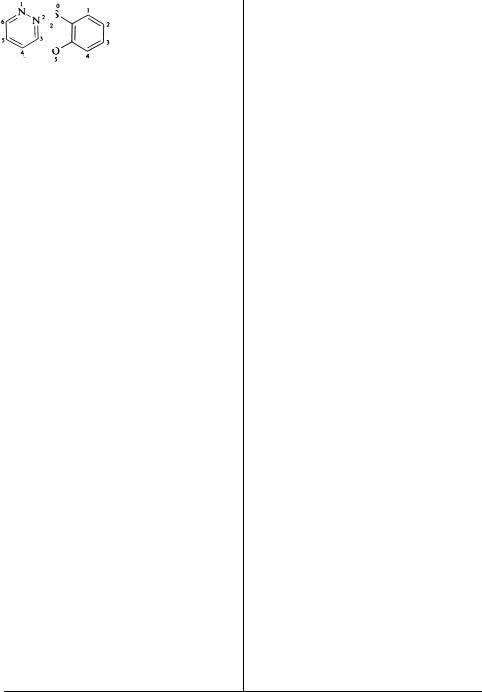
|
|
|
ORGANIC COMPOUNDS |
|
|
|
1.13 |
TABLE 1.5 |
Trivial Names of Heterocyclic Systems Suitable for Use in Fusion Names |
|
|
|
|||
Listed in order of increasing priority as senior ring system. |
|
|
|
|
|
||
|
|
|
|
|
|
|
|
Structure |
Parent name |
Radical name |
Structure |
Parent name |
Radical name |
|
|
|
|
|
|
|
|
|
|
|
Thiophene |
Thienyl |
|
|
2H -Pyrrole |
2 |
H -Pyrrolyl |
Pyrrole |
Pyrrolyl |
Thianthrene |
Thianthrenyl |
Imidazole |
Imidazolyl |
Furan |
Furyl |
|
|
|
|
Pyrazole |
Pyrazolyl |
Pyran |
Pyranyl |
|
|
(2H -shown) |
|
|
|
|
|
Isothiazole |
Isothiazolyl |
Isobenzofuran |
Isobenzo- |
|
|
|
furanyl |
Isoxazole |
Isoxazolyl |
|
|
Pyridine Pyridyl
Chromene |
Chromenyl |
(2H |
-shown) |
Pyrazine Pyrazinyl
Pyrimidine Pyrimidinyl
Xanthene* Xanthenyl
Pyridazine Pyridazinyl
Phenoxathiin Phenoxa-
thiinyl
* Asterisk after a compound denotes exception to systematic numbering.
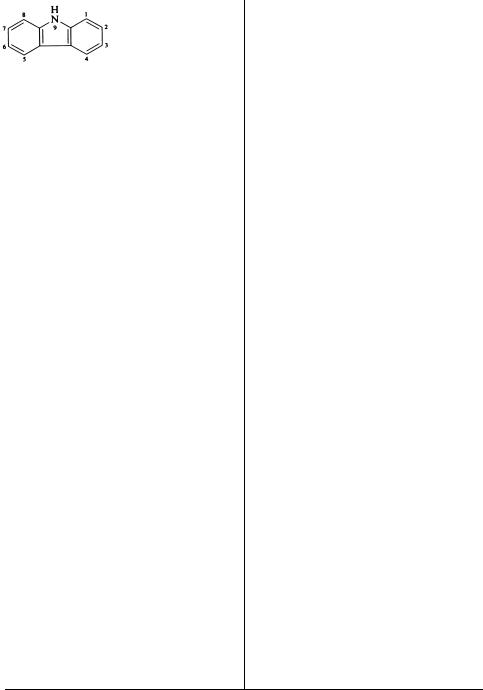
1.14 |
|
|
SECTION |
1 |
|
|
|
TABLE 1.5 |
Trivial Names of Heterocyclic Systems Suitable for Use in Fusion Names ( |
|
Continued |
) |
|||
|
|
|
|
|
|
|
|
Structure |
Parent name |
Radical name |
Structure |
Parent name |
Radical name |
|
|
|
|
|
|
|
|
|
|
|
Indolizine |
Indolizinyl |
|
|
Phthalazine |
Phthalazinyl |
|
Isoindole |
Isoindolyl |
Naphthyri- |
Naphthyri- |
|
|
|
|
||
|
|
|
dine |
dinyl |
|
|
|
(1,8-shown) |
|
3H -Indole |
3 |
H -Indolyl |
|
|
|
|
|
Quinoxaline |
Quinoxalinyl |
Indole |
Indolyl |
Quinazoline Quinazolinyl
1 H -Indazole |
1 |
H -Indazolyl |
Cinnoline Cinnolinyl
Purine* Purinyl
Pteridine Pteridinyl
4H -Quin- |
4H -Quin- |
olizine |
olizinyl |
Isoquinoline |
Isoquinolyl |
4 H - |
4 H - |
|
|
Carbazole* |
Carbazolyl |
Quinolone Quinolyl
Carbazole* Carbazolyl
* Asterisk after a compound denotes exception to systematic numbering.
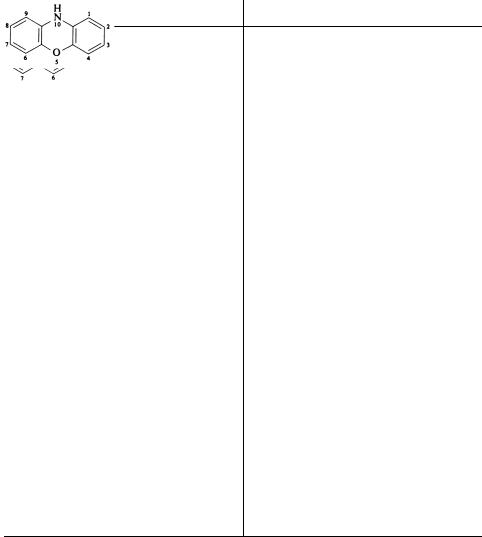
|
|
|
ORGANIC COMPOUNDS |
|
|
1.15 |
TABLE 1.5 |
Trivial Names of Heterocyclic Systems Suitable for Use in Fusion Names ( |
Continued |
) |
|||
|
|
|
|
|
|
|
Structure |
Parent name |
Radical name |
Structure |
Parent name |
Radical name |
|
-Carboline |
-Carbolinyl |
Phenazine |
Phenazinyl |
Phenanthri- |
Phenanthri- |
Phenarsazine |
Phenarsazinyl |
dine |
dinyl |
|
|
Acridine* Acridinyl
Phenothiazine Phenothiazinyl
Perimidine Perimidinyl
Furazan Furazanyl
Phenanthroline |
Phenanthrolinyl |
|
(1,10-shown) |
Phenoxazine |
Phenoxazinyl |
* Asterisk after a compound denotes exception to systematic numbering.
If there is a choice among heterocyclic systems, the parent compound is decided in the following order of preference:
1.A nitrogen-containing component
2.A component containing a heteroatom, in the absence of nitrogen, as high as possible in Table 1.3
3.A component containing the greater number of rings
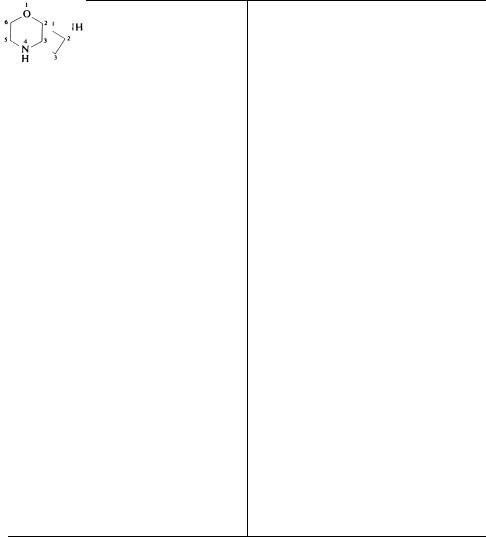
1.16 |
SECTION 1 |
TABLE 1.6 Trivial Names of Heterocyclic Systems That Are Not Recommended for Use in Fusion Names
Listed in order of increasing priority.
Structure |
Parent name |
Radical name |
Structure |
Parent name |
Radical name |
|
|
|
|
|
|
|
|
|
|
|
|
|
Pyrazoline |
Pyrazolinyl |
|
|
|
|
|
(3-shown*) |
|
Isochroman Isochromanyl
Piperidine Piperidyl†
Piperazine Piperazinyl
Chroman Chromanyl
Pyrrolidine Pyrrolinyl
Pyrroline |
Pyrrolinyl |
|
(2-shown*) |
Indoline |
Indolinyl |
|
||
Imidazolidine |
Imidazolidinyl |
|
|
Isoindoline |
Isoindolinyl |
Imidazoline |
Imidazolinyl |
|
(2-shown*) |
|
|
|
Quinuclidine |
Quinuclidinyl |
|
Morpholine |
Morpholinyl‡ |
Pyrazolidine |
Pyrazolidinyl |
|
* Denotes position of double bond.
† For 1-piperidyl, use piperidino.
‡For 4-morpholinyl, use morpholino.
4.A component containing the largest possible individual ring
5.A component containing the greatest number of heteroatoms of any kind
6.A component containing the greatest variety of heteroatoms
7.A component containing the greatest number of heteroatoms first listed in Table 1.3
